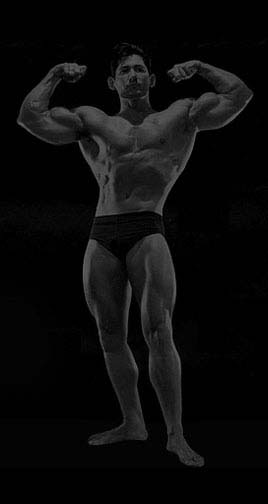While it is possible to lose more than one pound per week through further calorie reduction or by increasing
aerobics, you will lose some muscle along with the fat. On paper, your body will look as if the diet is working. The mirror,
however, will tell a different story. Even a 5 percent change in calories or aerobics will cause muscle loss.
The first way to prevent muscle loss is to change the fat to carbohydrate ratio. In the Iso-Caloric Diet, these are changed
to: 1/3 Protein 1/3 Fat and 1/3 Carbohydrate. Adjusting these ratios will cause faster fat loss. Although there is
a scientific explanation for this phenomenon, I first discovered it the hard way through trial and error. No other combination
worked.
At first, it seemed logical to try reducing calories further, but this caused too much muscle loss too quickly. Does increasing
protein help maintain muscle mass? Nope, it doesn't. Increasing aerobics looks like a popular choice -- after all, gyms have
lots of steppers and rowers and bikes, all occupied with well-meaning individuals. Aerobics must be good, right? Wrong! As
a matter of fact, increased aerobics causes just as much muscle loss as calorie restriction.
After screwing up in so many other ways, I finally arrived at the 1/3 ratios. Most athletes won't be happy with this. They've
been conditioned not to eat dietary fat. Besides, lowering carbohydrates increases hunger and anxiety for a while. However,
eating lots of carbohydrates makes your metabolism unable to burn fat efficiently.
If you have patience and not too much fat to lose, you will probably get damn close to your goal with the Modern Diet.
The Modern Diet will allow you to be relatively happy, sociable, energetic and feed your carbohydrate addiction.
When "damn close" isn't close enough, you need the Iso-Caloric Diet. Will you be hungrier? Only at first. Will your strength
decrease? Again, only at first. Will you loss muscle? Less than you would with any of the other alternatives.
In the Iso-Caloric Diet, we are once again concerned with the quality of the body's energy sources, not the quantity. Some
people will object to eating a diet that is 1/3 fat. Fat is B-A-A-A-D, isn't it?
Fat isn't perfect, but it's all we have to work with. We can't decrease total calories because we don't want to lose muscle.
The high carbohydrates of the Modern Diet will need to change to either protein or fat. Exchanging the carbohydrates for protein
won't work because not all of the amino acids can be converted into energy. Much of the amino acid content is excreted as
urea, a waste product. Calorie for calorie, protein will not provide the same energy as carbohydrates. This is why high protein
diets cause faster fat loss than high carbohydrate diets. Because protein has less usable energy, the body will strip down
muscle to scavenge the energy-producing amino acids. Glutamine will be used first, then the branched-chain amino acids, then
alanine.
If we can't eat protein, all that's left is fat. Eating more fat will also reduce insulin secretion and make the fat-burning
energy pathways more efficient. In the presence of insulin, the body will not release stored fat for energy. Therefore, as
dieters, we want to reduce insulin secretion.
In the future, there may be better alternatives. The latest nutritional research shows that dietary pyruvate and lactate
can activate alternative energy cycles that work better than fat or protein. These future foods will not cause insulin secretion,
allowing faster fat loss while preserving more muscle from catabolism. Right now, however, these options are both tantalizing
and futile. Currently, both pyruvate and lactate are hard to find, expensive, bad-tasting and boring to eat.
Almost all fat -- saturated or not, essential or not -- will work in the Iso-Caloric Diet. Energy-wise, it doesn't matter.
You could use MCTs, for that matter, but they're are not as much fun as an additional serving of oily fish, walnuts or avocado.
If you followed my recommendations for fat choices in the Modern Diet, you are eating mostly essential fats. You would
be shocked at how little fat you'll need to eat to increase fat calories by 23 percent. Salad and cooking oils don't take
up much room. It doesn't take many avocados or walnuts to add a lot of calories. How about -- dare I say it -- peanut butter
(no trans, that is)? Surely this isn't diet food.
Some people have asked me: If the Iso-Caloric Diet is so superior to the Modern Diet, why didn't I recommend it first?
Well, most people are used to something like the Modern Diet. It's easy to start, "believe" and follow. Each change in longstanding
habits requires more discipline.
Why increase protein by 8 percent? Fatty foods usually contain protein. Eggs, fish, meat, and that slice of cheese you
can finally eat all contain protein in addition to fat. Even peanut butter contains protein.
The Iso-Caloric Diet requires more discipline than the Modern Diet, but if you're impatient, or have an inflexible timetable,
the Iso-Caloric Diet will get you virtually all the way to your goals. The Modern Diet won't. Of course, strength and energy
will suffer for about 5 days, but after that, you'll feel even better than before.
The Iso-Caloric Diet begins to solve a major problem in dieting (aside from hunger and anxiety): impatience. While the
problem of impatience has not been completely solved, we've appeased it for now. Although there is a better diet plan to come,
it is illuminating to examine the preliminary solutions to the dilemmas I've encountered in my years as a professional body
confidante.
